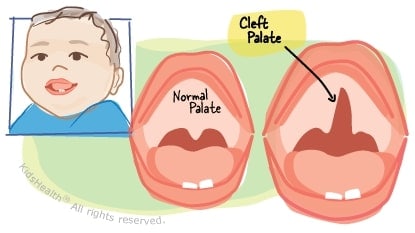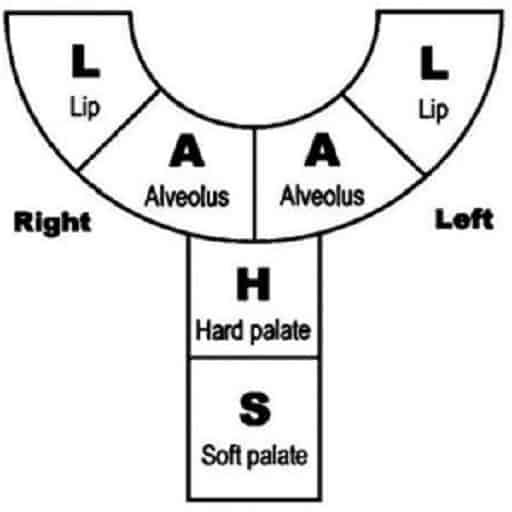CLEFT PALATE
CLEFT PALATE
- Cleft palate is a type of clefting (fissure or gap) congenital deformity caused by abnormal facial development during gestation.
- Imperfect fusion or developmental anomalies of median nasal process, maxillary process and palatine process (which fuses around 6-8 weeks of intrauterine life).

ETIOLOGY-
- Genetic predisposition
- Environmental factor (drugs like steroids, diazepam, phenytoin)
TYPES OF CLEFT PALATE-
I) According to the extension-
- Incomplete-
- Cleft of the hard palate remains attached to nasal septum and vomer and leads to Bifid uvula, whole length of soft palate is bifd.
2. Completed-
- Nasal septum and vomer are completely separated from palatine processes.
- Then nasal cavity and mouth are interconnected.
II) Accordimg to location-
1. Unilateral
2. Bilateral
II. Classification of degrees of cleft palate:
- First: Cleft or bifid uvula
- Second: Presence of ununited palatal process
- Third: Presence of united palatal process and a cleft on one side of pre maxilla
- Fourth: Presence of united palatal process cleft on both sides of palatal process
- Fifth: Presence of bilateral cleft lip and jaw due to failure of fusion of premaxilla with palatal process.


CLINICAL FEATURES-
- Difficulty in swallowing
- Speech difficulty
- Upper lateral incisors may be absent or teeth crowding seen.
- Feeding difficulties in infants
- Ear infections and hearing loss.
- Associated anomaly is Pierre- Robin syndrome.
- Cleft lip, cleft palate, scalp defects suggest Trisomy 13 or Patau syndrome.
- Trisomy 13 and Trisomy 18 share several clinical features.
- The highest discriminatory values are for ectodermal scalp defects and harelip and cleft palate in trisomy 13 and elongated skull and simple arches on all digits for trisomy 18

DIAGNOSIS-
- Prenatal ultrasound can detect a cleft palate before child birth.
TREATMENT-
- Best balance is achieved by repairing cleft palate between one and half years of age (12- 18 months).
- Palate is repaired by palatal shalves (mucoperiosteal flaps)
- Most commonly used method is V- Y pushback palatoplasty
- LAHSAL system of classification

For bilateral CL and CP
- No cleft- Dot
- Complete cleft- Capital letter
- Incomplete cleft- small letter
Exam Important
- Cleft palate is a type of clefting (fissure or gap) congenital deformity caused by abnormal facial development during gestation.
- Imperfect fusion or developmental anomalies of median nasal process, maxillary process and palatine process (which fuses around 6-8 weeks of intrauterine life).
TREATMENT-
- Best balance is achieved by repairing cleft palate between one and half years of age (12- 18 months).
- Palate is repaired by palatal shalves (mucoperiosteal flaps)
- Most commonly used method is V- Y pushback palatoplasty.
Don’t Forget to Solve all the previous Year Question asked on CLEFT PALATE
Click Here to Start Quiz
Click Here to Start Quiz
